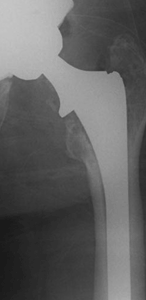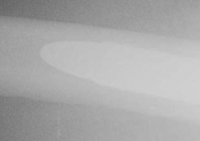Cylindrical stem insertion: A simple technique applicable in a majority of femoral reconstruction cases
 Robert L. Barrack |
The extensively coated cylindrical stem is a versatile strategy for achieving stable reconstruction of the femur during revision hip procedures. The advantages are mechanical stability, reliable ingrowth and the documented clinical results.
It is a simple and alluring concept. You ream a cylinder, you replace it with a cylinder and you get 4 cm to 6 cm of scratch-fit so that you can obtain immediate mechanical stability, both axial and rotational, and an adequate interface for bone ingrowth for long-term stability.
Key principles
While simple conceptually, it is a potential disaster unless you follow certain principles. Use the shortest stem that achieves adequate fixation. When using a stem longer than 6 in to 7 in, it is crucial to get a lateral X-ray to get an idea of the bow of the femur. Most studies show that stems longer than 6 in to 7 in, unless the patient is a very tall male, will cause a conflict with the anterior bow. A bowed stem will often be needed in these cases.
All cement debris must be removed. Begin reaming laterally to avoid varus positioning or a well-fixed stem with a reamed-out lateral cortex. Do not ream longer than necessary, not even 5 mm longer. It is important to recognize deformities and liberally use extended osteotomies and bowed stems in their presence.
Selecting the stem
The stem choice depends on the degree of bone deficiency. For a type 1 femur, a revision stem is not necessary. A fully coated primary stem will get the job done.
A type 2 femur is characterized by extensive metaphyseal bone loss but an intact diaphysis. This is probably the most common pattern. Again, use the shortest stem possible, preferably straight. Stay within the range of 6 in to 7 in whenever possible. A longer stem is not required. You do not have to bypass the previous stem. You just have to bypass significant biomechanical weakness in the femur. Use intraoperative X-rays when in doubt. Calcar contact is not necessary with these extensively coated stems.
For a typical type 2 femur that is fibrous ingrown, it is important to use power tools to get as lateral as possible. If it is fibrous ingrown, it is not necessary to do an extended trochanteric osteotomy. You can use instruments that attach directly to the stem, and you can power out these stems if they are fibrous ingrown.
|
|
Images: Barrack RL |
The next order of business is to get far enough lateral so that you can go straight down the femur with a straight stem if possible. It is a little bit of a balancing act; be careful not to break the trochanter.
A lighted instrument can be used that allows you to see the pedestal distally and to drill through it. It is relatively safe as long as you are very far lateral and you perforate the pedestal.
Use flexible reamers for long bowed stems and straight reamers for straight stems. Again, lean into valgus and start laterally. It is a simple principle. You are looking for 4 cm to 6 cm of the scratch-fit — so that the reamer has to slow down and bite on cortical bone for a distance of 4 cm, up to 6 cm. You do not need more than that; 4 cm to 5 cm is optimal.
The reamer will slow down, and when you get to that point, do a trial to see how high the broach sits. The broach does not have to go all the way down. If it is up more than 10 mm, you may consider a calcar replacement. If it is rotationally stable within 10 mm, then you can just plan on leaving your component up — proud — 5 mm to 10 mm. It is not a particular problem. Do not try to seat these fully just so they look better on X-ray.
Pushing the limits
|
|
A type 3a femur pushes the limits of an extensively coated cylindrical stem. In this type of femur with severe damage, some deformity and an intact isthmus, you should routinely perform an extended trochanteric osteotomy. This is where most of us stop — at the 17-mm to 18-mm range. If you need more than that, you would probably use a tapered stem.
A typical type 3a femur will have some degree of deformity and require remodeling, so we do an extended trochanteric osteotomy. If a stem longer than 7 in to 8 in is required, I recommend using a bowed stem and flexible reamers. Once again, get to the point where you are sure you are down the middle and the reamer slows down for 4 cm to 5 cm. Occasionally, you need to over-ream with the bowed stems.
You want to mark the area where you first get cortical chatter, and you want that to occur at an area of over 4 cm to 5 cm. Using a broach trial, frequently you are going to have to make room medially. Use a power tool to allow the medial flare to seat without excessively lateralizing and putting the stem in too much valgus. This allows closing of the osteotomy and better contact.
Hole gauges
To judge your final reaming, hole gauges are helpful. The nominal diameters of the reamers and the components are plus or minus 0.5 mm. It is good to know the actual diameter of these components. The final reaming should be checked and compared to the core diameter of the stem.
When introducing this fully coated cylindrical stem, mark the amount that it is going to be proud — probably several millimeters. Be sure to get a scratch-fit over 4 cm to 5 cm.
This impacts and stays proud, and this is your basic principle of cylindrical stem insertion: host contact and scratch-fit over an area of 4 cm to 6 cm. Remember to check the length and stability. The osteotomy site should close down nicely.
Cylindrical stems are a simple technique, applicable to the majority of cases — most type 1, 2 and 3a femurs. The details of the technique are crucial to avoid complication and achieve predictable results.
![]() Robert L. Barrack, MD, can be reached at 1 Barnes-Jewish
Hospital Plaza, 11300 West Pavilion, St. Louis, MO 63110; 314-747-2562; e-mail:
barrackr@wudosis.wustl.edu. He has received royalties and
research support from Smith & Nephew in the past 12 months.
Robert L. Barrack, MD, can be reached at 1 Barnes-Jewish
Hospital Plaza, 11300 West Pavilion, St. Louis, MO 63110; 314-747-2562; e-mail:
barrackr@wudosis.wustl.edu. He has received royalties and
research support from Smith & Nephew in the past 12 months.
![]() Follow
OrthoSuperSite.com on Twitter
Follow
OrthoSuperSite.com on Twitter



